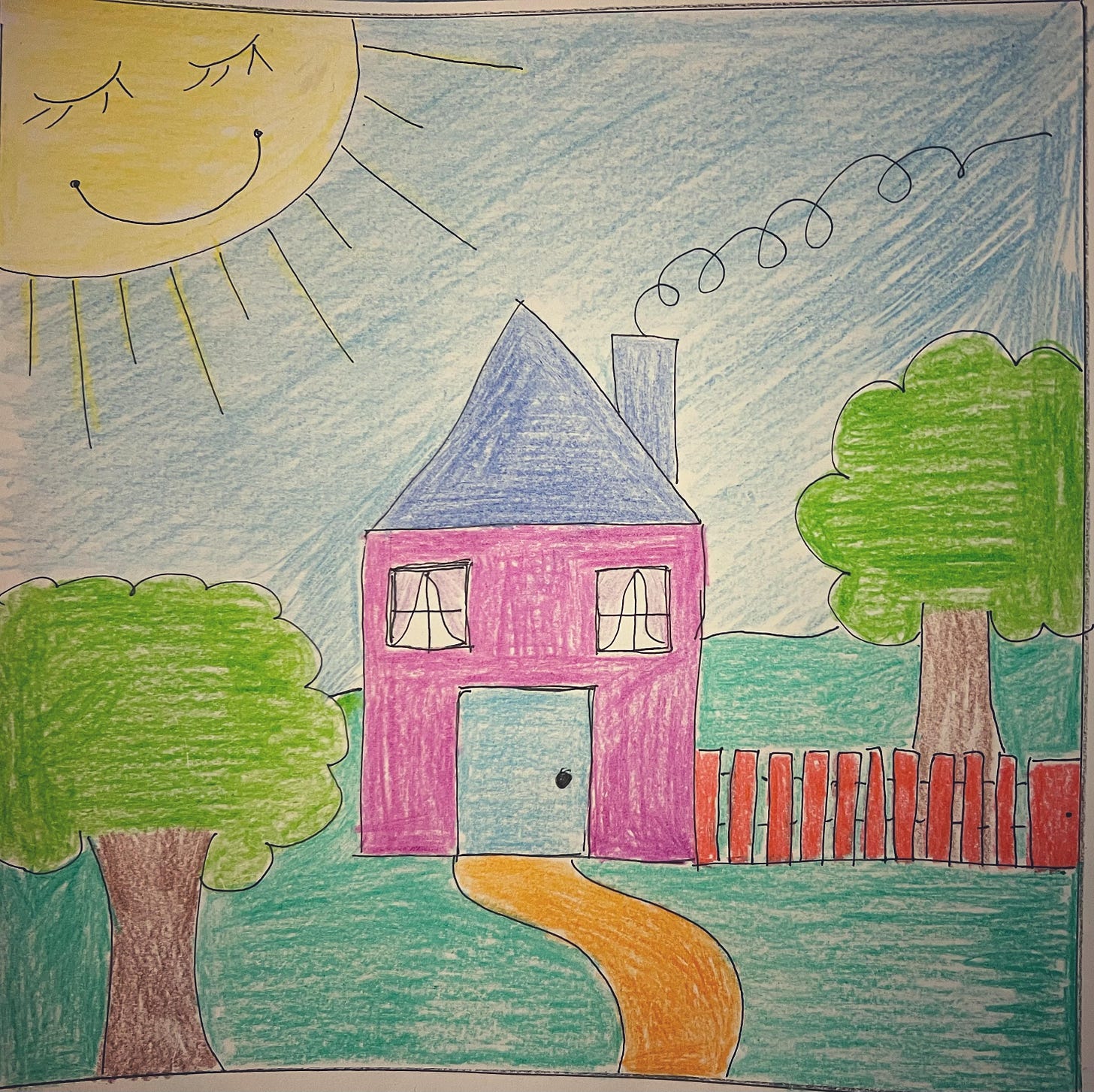In psychotherapy, ‘metanoia’ describes a profound personal conversion or turning point; a radical transformation of character or personality. It’s a changing of mind and heart. What does this transformative path look like? What tools will we need? Philosophy and poetry; mystery and intuition; courage and curiosity—and creative expression. Join me on Metanoia Road.
Dear You—
In my last letter, which you can read again here, I wrote of an upside-down house. But when I first began writing about the Scottish cottage I have called home since late 2018, I wrote in fiction. There is something helpful about fiction. When we write fiction, we are not ‘contracted’ to write the factual truth of our life experiences. Sometimes, the bare facts of our life situation can keep us locked in a mental prison, narrow our perspective, and make us stagnant and unimaginative. But fiction can open us up. Fiction invites us to take an imaginative leap of faith into our life story and to see what else is possible. We might start the story somewhere else. We might write different endings. We can be flexible about what our story means, where it is heading, and what our role is within it and with others in the story. In psychotherapy, psychological flexibility is an important concept. Being psychologically flexible means:
Recognising and adapting to different situations and demands
Changing our mindset or behaviour when our current strategies are not working well
In my last letter, I wrote about despair as the place we go to when we can’t figure out a way to move through a situation. In this situation, psychological flexibility is absent. I couldn’t see an alternative route. I couldn’t see a way to move through the situation.
Fiction can help us find a way to move through a situation. The story below is a true story, but not a factual story. I was writing to find a way to express the experience of that early cottage life and to explore what it might be like to move through that despair—what might an ending feel like?
Also, because I would share the story1, I wanted to know if it was okay and safe to do so. What would readers think? Fiction provided me with some armour, as it were, to step into the world with this story. But fiction writing also has its risks. When I posted the booklet containing my story to one of our friends, she wrote back saying she couldn’t read it to the end, was quite disturbed and hoped that none of it was true.
And on that note, here’s the story.
The Happy House
After he left, Adele understood she still loved Greg. She also understood about the house. Here she is. Greg’s been gone a few weeks and she’s taking the bins out for the very first time, dragging them over the gravel to their designated place on the pavement just across from the sheep-speckled field and the foot of the burn, and now turning back to the house, she captures it in full, it seems, for the very first time. And she’s struck with a sense of recognition, and a memory. It’s a happy house. She says. And her eyes widen in wonderment, which they haven’t done in a very long time. She’s right. It really is a happy house. In fact, it’s “The Happy House.”
In the summer of 1975, she must have drawn “The Happy House” a hundred times. She was five—that kid in her happy pink and white room, with her happy stuffed toys, her happy pink ballerina blanket, and her happy pink and white dressing table, at which she sat drawing her happy houses or swiveling around to sauté into a plié and then pirouette to the mirrored audience of her wardrobe doors.

It was years later, in design school, that she read Bachelard’s The Poetics of Space and recognised he was describing her happy houses. Their simple square scaffold. Their grounded, single story. Their peaked roof. Their strong-framed front door, always at the very centre. Their windows, always two, and one on each side of the door, as if symmetry meant happy. And then, their chimney, built up on the top right of the roof with its fat, swirling strokes, suggesting a father at the fireplace, a warm, motherly kitchen, and the comfort of a family home. To the side of the houses, the brightest and fluffiest trees, straight and tall protectors. Above them, chubby baby-blue horizontal lines and always, always to the very right, the round yellow sun leaning into the happy scene from the page corner, smiling, because suns are hot burning masses of smiles, making everything even happier than happy.
At five, she’d never seen a house that looked like that. She’d only seen cramped terrace houses and shabby old flats. But she was happy. Unhappy children, you might have seen them in the movies, draw warped versions of the Happy House. Their windows are black. Their skies are black. And there isn’t a smiling mass of sunlight in sight.
Which is rather what Greg and Adele’s house had looked like for months. It was one of the darkest storms in a century. One of the dullest suns for years. And Greg’s cardboard boxes, torn into sheets to fit over the house’s windows, made the stone-cold interior darker and drearier than hell.
Greg’s nervous breakdown had come catastrophically. In the mathematical sense, that is. One day, he was leading Adele on a stable, predictable, and continuous trajectory towards a sprawling villa in the south (make millions; sell company; retire in luxury); the next, he’d abruptly discontinued life’s trajectory. He’d dragged Adele back out over the threshold of their magnificent metropolitan apartment in the dead of night (that’s how Adele remembered it) and the next morning she’d woken up in this small house between a large body of water and nowhere.
“Could I have a cup of tea and a biscuit?” Greg said.
And that was it.
Greg and Adele had been married for nine years after previously having been married for twenty years and seventeen years respectively. For their first eight years, they lived fast and fabulous in the brightest and most spacious hotel rooms and apartments, perched high above a city’s foundations, all paid for by Greg’s start-up. In their ninth year together, they fell into this small house.
It soon became clear that Greg and Adele were meant to use the little house to hide for a while.
In theory, the simplicity of an eensy-weensy house is comforting because it implies that life is easy, cheery, and sunshiny—child’s play. But in reality, things were much more ambiguous. A happy house could be a bankrupt house.
But that’s nobody’s business. No one should judge a person by the house they inhabit.
So many monstrous things can happen in a simple, small house. Here are some.
You can lose your blood.
You can lose your sex.
You can lose your money.
You can lose your mind.
“Do you feel like murdering your husband?” Said Adele’s new doctor in the single building block of a medical clinic in the nearest village.
“No!” Adele said. “Is that what I have to look forward to?”
“It’s what most women say they feel.”
Honestly? The only thing Adele felt about her husband was that she felt like leaving him.
This feeling was so strong it was more than a feeling. It was a plan. It was a plan with its own schedule and its own checklist.
But Greg left first.
He picked up their retirement campervan and started the long drive down south to what would be their sultry, warm resting place.
“This wee house is as much camping as I can stand,” Adele said. She was in the kitchen texting Greg who was in the sitting room texting her about their alternative retirement plans.
Greg leaves. Adele stays. Here she is taking the bins out for the very first time. It’s easy enough work. Everything’s easier now. As she steps back into the house, she’s like a visitor taking in information about the people who live here. Everything is deliberately arranged.
There’s a specific story she wishes to tell. In the kitchen, a vase of fresh flowers. Care for a chat? In the sitting room, the large recliner, in masculine tones, and a side table with a short pile of two or three books and a setting for tea. Care for a cup of tea and a biscuit? The fireplace is on standby with its kindling and logs. Care for a cuddle and a movie? On the walls—now there’s the ambiguous part of the story—mirrors. Mirrors everywhere, even beyond the sitting room into the hall and into the bathroom and upstairs too. Care for a brighter and enlarged room? Care to sauté and plié and pirouette? Care to see yourself, see what you’ve become?
It’s easy to hide in a small, simple house if it’s just you and your happy childhood memories of a happy house you drew years and years and years ago. They say that memory is identity, that you are what you choose to remember. Did Greg already know this when he left ahead of her? Was he offering her the opportunity to imagine life without him? Did he know how the house would change when he left? How the bed would widen, how his recliner would soften, how his wardrobe would ache to hold his coats again?
Here, take the house. Try it on your own. Try it without me. Use it to survive. To live. Then leave it. Just leave it and come and forgive me. We’re in this together, remember, this thing called life and soon, well, soon we’ll both be dead and gone and soon after that we’ll both be forgotten. So. Try it all out. Try it out and then come. Come.
Until my next letter,
Meet me in the comments section:
Thank you for reading this letter. I’d love to know if this resonated with you.
Does the idea of writing through trauma with fiction appeal to you? Have you written a life story as a fiction? I’m curious to learn more!
Also—if you have kept your own drawing or painting of your childhood’s Happy House or if you have your children’s, please do share! I’d love to see them!
Also again—if you listened to the voiceover—let me know if it is an enhancement and shall I continue?
It was commissioned by Open Book Unbound, published in Unbound and was read and discussed on the Unbound Podcast.








I really enjoyed this post KK, and the story is supurbly written. I wanted to meet you here in the comments section, as per your invite, but I don't really have a lot of experience of writing through trauma. I don't know if the following is of interest: after my aunt's suicide I stuggled a lot with wanting to write about the grief, pain, guilt, but everything I wrote came out strange and sounded alien to me. In the end I learnt that I needed some distance from the emotion to be able to write about her, fictionally or otherwise. That was just my experience. In general, I find it find hard to draw a line between lifewriting and fiction and often just mix them up. Looking forward to more post from Metanoía Road!
Kathryn, so good to hear from you and listen to your voice telling the tale. Your “fiction” grabbed me. I have now read it. Cinny and I listened over breakfast. Emotional edgy….with keen images. I have been writing “tales from an average and ordinary life” for over a year. They are short short stories. Working with memories. Riddled memories that allow me to embellish a bit. Your writing encourages me to go further. I have been fearful of making fiction. Thanks for modeling and pushing me to be bold. Looking forward to Part 2.